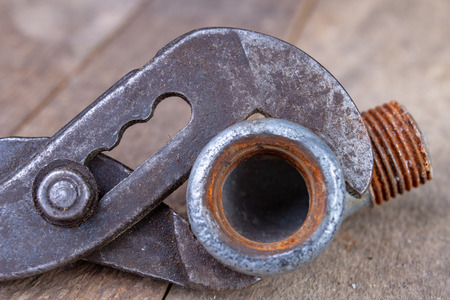1. Understanding Galvanized Pipes
If you live in an older home built before the 1960s, there’s a good chance your plumbing system includes galvanized pipes. These pipes were commonly used for water supply lines because they were seen as a strong and durable option at the time.
What Are Galvanized Pipes?
Galvanized pipes are steel pipes that have been coated with a layer of zinc to prevent rust and corrosion. This protective coating was meant to extend the life of the pipe and make it suitable for transporting water throughout the home. Over time, however, the zinc coating wears down, exposing the steel underneath to moisture and air—which leads to rust and corrosion.
Why Were They Used in Older Homes?
Back in the day, galvanized steel was considered an upgrade over lead pipes. It was affordable, readily available, and seemed like a long-lasting solution for household plumbing. For decades, it was the standard choice for indoor water supply systems across many parts of the United States.
Common Problems with Galvanized Pipes
As these pipes age, several issues tend to develop that can affect both your plumbing system and your health. Here are some of the most common problems:
| Problem | Description |
|---|---|
| Corrosion | Over time, rust builds up inside the pipes, reducing their diameter and weakening their structure. |
| Low Water Pressure | The buildup of rust and mineral deposits narrows the flow path, leading to noticeable drops in water pressure. |
| Discolored Water | Rust particles can flake off into your water supply, causing brown or yellow water that stains sinks and laundry. |
| Leaks | Corroded sections become brittle and prone to cracking or bursting, especially under high pressure. |
| Potential Lead Contamination | If original lead service lines are connected to galvanized pipes, lead particles can accumulate on rusted surfaces and enter your drinking water. |
How to Identify Galvanized Pipes in Your Home
You can usually identify galvanized pipes by their grayish color and threaded joints. If youre unsure whether your home has galvanized piping, try this simple test: scratch the surface of an exposed pipe with a key or coin—if it reveals a silver-gray color underneath a dull finish, its likely galvanized steel. You can also use a magnet; galvanized steel is magnetic, unlike copper or plastic alternatives.
Tip:
If your home still has galvanized plumbing, its worth having a licensed plumber inspect it—even if everything seems fine on the surface. Many problems develop inside the pipe where you cant see them.
2. Signs It’s Time to Replace Your Pipes
Old galvanized pipes were once the standard in American homes, especially those built before the 1960s. However, over time, these pipes corrode from the inside out, leading to various plumbing issues that can affect your water quality and overall home safety. Knowing when its time to replace your galvanized pipes is crucial to avoid costly damage.
Common Warning Signs of Failing Galvanized Pipes
If you’re wondering whether it’s time to upgrade your home’s plumbing system, here are some key signs that your galvanized pipes may be on their last legs:
1. Rusty or Discolored Water
One of the most obvious indicators is brown, yellow, or reddish water coming from your faucets. This discoloration is caused by rust breaking off from the inside of the pipes and mixing with your water supply.
2. Low or Inconsistent Water Pressure
As galvanized pipes corrode internally, they become narrower due to the buildup of rust and mineral deposits. This restricts water flow, leading to reduced pressure at sinks, showers, and other fixtures.
3. Frequent Leaks
Aging galvanized pipes are more prone to developing leaks because corrosion weakens the pipe walls. You might notice wet spots on walls or ceilings, or even mold growth in areas you didn’t expect.
4. Uneven Water Temperature
If youre experiencing sudden changes in water temperature while using hot or cold water, it could be a sign of pipe blockage or corrosion interfering with proper flow and pressure balance.
Comparison Table: Healthy vs. Failing Galvanized Pipes
| Condition | Healthy Pipes | Failing Galvanized Pipes |
|---|---|---|
| Water Color | Clear and clean | Rusty or discolored |
| Water Pressure | Consistent and strong | Low or fluctuating |
| Leaks | None or very rare | Frequent or recurring leaks |
| Lifespan Remaining | 20+ years (if modern material) | Usually expired (40-60 years old) |
How to Confirm If You Have Galvanized Pipes
If you’re not sure whether your home has galvanized plumbing, try this simple test: Locate an exposed pipe in your basement or utility room. Scratch the pipe with a screwdriver—if it reveals a silver-gray color underneath, it’s likely galvanized steel. You can also use a magnet; if it sticks, chances are it’s a galvanized pipe.
Tip:
If your neighbors have already replaced their old plumbing systems and you live in a similar-aged home, theres a good chance yours needs attention too.
If you notice any of these signs in your home, it may be time to start planning for a full pipe replacement to ensure safe and reliable plumbing for years to come.
![]()
3. Planning Your Pipe Replacement Project
Before jumping into replacing old galvanized pipes, its important to take some time to plan your project carefully. This will help you avoid surprises, stay within budget, and make smart decisions about materials and the scope of work.
Budgeting for Your Repipe
The cost of replacing galvanized pipes can vary widely depending on the size of your home, accessibility of plumbing lines, and whether youre doing a partial or full repipe. Here’s a rough breakdown to help you get an idea:
| Type of Project | Estimated Cost (USD) |
|---|---|
| Partial Repipe (1-2 rooms) | $1,500 – $4,000 |
| Full Repipe (average home) | $6,000 – $15,000+ |
Choosing the Right Materials
Two popular choices for replacing old galvanized pipes are copper and PEX. Each has its pros and cons, so it’s important to understand what works best for your home and budget.
| Material | Pros | Cons |
|---|---|---|
| Copper | Durable, long-lasting, resists bacteria growth | More expensive, labor-intensive to install |
| PEX (Cross-linked Polyethylene) | Flexible, cost-effective, quicker installation | Sensitive to UV light, may not be allowed in all areas |
Deciding Between a Full or Partial Repipe
This decision depends on factors like the age of your plumbing system, frequency of leaks, and your renovation plans. A full repipe is more costly upfront but can prevent future issues. A partial repipe might be enough if only certain sections are failing.
When to Choose a Full Repipe:
- Your entire plumbing system is made from galvanized pipes
- You’ve had multiple leaks or water pressure issues
- You’re already remodeling your home extensively
When a Partial Repipe Might Work:
- You have limited budget right now
- Only one area of the house is affected by pipe problems
- The rest of the plumbing system is in decent shape
Other Key Considerations
Don’t forget about permits and building codes in your city or state. In many places across the U.S., youll need a licensed plumber to pull permits and ensure everything meets local regulations. Also, plan ahead for how long the project will take—full repipes can take several days to complete.
By taking the time to plan properly—considering costs, materials, and the extent of your project—you’ll set yourself up for a smoother pipe replacement experience with fewer headaches down the road.
4. Working with Licensed Plumbers
Replacing old galvanized pipes is not a DIY project for most homeowners—it requires professional expertise to ensure the job is done safely and up to code. Hiring a licensed and insured plumber is essential, but how do you make sure youre choosing the right one? Heres what you need to know.
How to Hire a Licensed and Insured Plumber
First, always verify that the plumber youre considering is licensed in your state. You can usually check this through your states contractor licensing board website. A licensed plumber has passed exams and met local training requirements, which helps guarantee they know current building codes and safety standards.
Insurance is just as important. Ask for proof of both liability insurance and workers compensation. This protects you in case of accidental damage or injury on your property during the project.
Check References and Past Work
Dont be afraid to ask for references. A reputable plumber should be able to provide contact info for past clients who can vouch for their work. Ask these previous customers about things like:
- Was the work completed on time?
- Did they stick to the budget?
- Were there any surprises?
- Would you hire them again?
You can also check online reviews on platforms like Google, Yelp, or Angi (formerly Angie’s List).
Know What Permits Are Required
Most pipe replacement jobs require permits from your local building department. Your plumber should know which permits are needed and be willing to pull them on your behalf. If they tell you a permit isn’t necessary when it clearly is—consider that a red flag.
Permit Checklist
| Item | Description |
|---|---|
| Plumbing Permit | Usually required for full pipe replacement projects |
| Inspection Schedule | Your city may require inspections before, during, and after work |
| Licensed Contractor Requirement | You typically need a licensed plumber to pull permits |
Get a Detailed Estimate in Writing
A clear written estimate helps avoid misunderstandings later on. The estimate should include:
- Total cost breakdown (labor, materials, permits)
- Estimated start and finish dates
- Payment schedule (e.g., deposit amount, milestone payments)
If something isn’t clear in the estimate—ask questions. A good plumber will be happy to explain everything up front.
5. What to Expect During the Process
Replacing old galvanized pipes is a big project, but understanding what to expect can help you feel more prepared and less stressed. Here’s a breakdown of how the process typically goes, how it may impact your day-to-day life, and what kind of demolition or restoration might be involved.
Typical Timeline for Pipe Replacement
The timeline can vary depending on the size of your home and whether you’re replacing all plumbing or just certain sections. Heres a general idea of what you can expect:
| Day | Activity |
|---|---|
| Day 1 | Initial inspection, water shut-off, and prep work |
| Day 2-4 | Removal of old galvanized pipes and installation of new piping |
| Day 5 | Pressure testing and inspection by local authorities (if required) |
| Day 6-7 | Patching drywall, restoring walls or ceilings, cleanup |
How It Affects Your Daily Routine
Your daily routine may be disrupted during pipe replacement, especially if water needs to be shut off for extended periods. Most contractors will try to minimize inconvenience by working in stages or scheduling work when youre not home.
Common Disruptions Include:
- No running water during parts of the day
- Loud noises from cutting and drilling
- Dust and debris in work areas
- Limited access to kitchens or bathrooms while work is being done there
Demolition and Restoration Work
Since galvanized pipes are usually hidden behind walls, floors, or ceilings, some demolition is often necessary. Contractors may need to cut into drywall or flooring to access and replace the pipes.
You Can Expect:
- Cut-outs in drywall around pipe access points
- Possible removal of tile or flooring in some areas
- Patching, sanding, and repainting after pipe installation is complete
If youre concerned about the mess or disruption, talk to your contractor beforehand about containment measures like plastic sheeting or floor protection. Many experienced plumbers will include basic wall patching as part of the job, but full cosmetic restoration may require additional contractors like painters or drywall specialists.
Understanding each stage of the process will help you prepare for what’s ahead—and ensure that everything goes as smoothly as possible during your galvanized pipe replacement project.
6. Post-Replacement Tips and Maintenance
Now that your old galvanized pipes have been replaced, its important to take care of your new plumbing system to keep it running smoothly for years to come. Proper maintenance helps prevent future problems and ensures your water stays clean and safe.
Monitor for Leaks and Pressure Changes
After installation, keep an eye out for any signs of leaks or drops in water pressure. Even with professional work, connections may shift or settle over time. Heres what to watch for:
| Sign | What It Might Mean |
|---|---|
| Puddles near pipes | Possible minor leak at a joint |
| Water stains on walls or ceiling | A hidden leak behind drywall |
| Low water pressure in fixtures | A clog or partial blockage |
| Noisy pipes (banging or rattling) | Pipes may be loose or not secured properly |
Flush Your System
Your plumber likely flushed the lines after the replacement, but its a good idea to let cold water run from several faucets for 5–10 minutes after installation. This helps clear out any remaining debris and ensures fresh water is flowing through your new pipes.
Consider Installing a Water Filtration System
If you noticed rust-colored water or odd smells before replacing your pipes, you might still want to install a water filtration system. Even though new pipes solve many issues, minerals or contaminants can still enter your home’s water supply depending on your location.
Main Types of Water Filtration Systems:
| Type | Description |
|---|---|
| Whole-House Filter | Cleans all water entering your home; great for general use. |
| Under-Sink Filter | Treats drinking/cooking water at one faucet. |
| Faucet-Mounted Filter | Easily attaches to a kitchen tap; affordable but limited capacity. |
| Reverse Osmosis System | Highly effective for removing chemicals and heavy metals. |
Add a Water Softener If Needed
If you live in an area with hard water (high mineral content), consider installing a water softener. Hard water can cause buildup in pipes, appliances, and fixtures—even new ones. A softener helps extend the life of your plumbing and improves soap efficiency.
Signs You Might Need a Water Softener:
- White scale buildup on faucets or showerheads
- Dingy laundry even after washing
- Squeaky-feeling skin after bathing
- Frequent appliance breakdowns (dishwasher, water heater)
Create a Regular Maintenance Schedule
You don’t need to be a plumber to maintain your plumbing system. Here’s a simple checklist you can follow:
| Frequency | Task |
|---|---|
| Monthly | Check under sinks and around exposed pipes for leaks or moisture. |
| Every 6 Months | Clean aerators on faucets; check water pressure throughout the house. |
| Yearly | Sediment flush for your water heater; inspect outdoor spigots and hose bibs. |
| As Needed | Add salt to water softener; change filters in filtration systems. |
Avoid Harsh Chemicals in Drains
Chemical drain cleaners can damage even modern piping materials over time. Stick to natural methods like baking soda and vinegar, or use mechanical tools like a drain snake when needed.
The Bottom Line: Stay Proactive
Your new plumbing system is built to last, but regular attention makes all the difference. Keep track of small changes, schedule routine checks, and invest in filters or softeners if needed—your home’s water quality will thank you!


